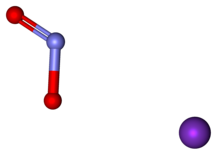Potassium nitrite

| |

| |
| Identifiers | |
|---|---|
3D model (
JSmol ) |
|
| ChEMBL | |
| ChemSpider | |
ECHA InfoCard
|
100.028.939 |
| EC Number |
|
| E number | E249 (preservatives) |
PubChem CID
|
|
RTECS number
|
|
| UNII | |
| UN number | 1488 |
CompTox Dashboard (EPA)
|
|
| |
| |
| Properties | |
| KNO2 | |
| Molar mass | 85.10379 g/mol |
| Appearance | white or slight yellow solid deliquescent
|
| Density | 1.914986 g/cm3 |
| Melting point | 440.02 °C (824.04 °F; 713.17 K) (decomposes) |
| Boiling point | 537 °C (999 °F; 810 K) (explodes) |
| 281 g/100 mL (0 °C) 312 g/100 mL (25 °C) 413 g/100 mL (100 °C) | |
| Solubility | soluble in alcohol, ammonia |
| −23.3·10−6 cm3/mol | |
| Thermochemistry | |
Heat capacity (C)
|
107.4 J/mol K |
Std enthalpy of (ΔfH⦵298)formation |
-369.8 kJ/mol |
| Hazards | |
| GHS labelling: | |
  
| |
| Danger | |
| H272, H301, H400 | |
| P210, P220, P221, P264, P270, P273, P280, P301+P310, P321, P330, P370+P378, P391, P405, P501 | |
| NFPA 704 (fire diamond) | |
| Flash point | Non-flammable |
| Lethal dose or concentration (LD, LC): | |
LD50 (median dose)
|
235 mg/kg |
| Safety data sheet (SDS) | External MSDS |
| Related compounds | |
Other anions
|
Potassium nitrate |
Other cations
|
Sodium nitrite |
Except where otherwise noted, data are given for materials in their standard state (at 25 °C [77 °F], 100 kPa).
| |
Potassium nitrite (distinct from
It is a strong oxidizer and may accelerate the combustion of other materials. Like other nitrite salts such as
Discovery
Production
Potassium nitrite can be obtained by the reduction of potassium nitrate. The production of potassium nitrite by absorption of nitrogen oxides in potassium hydroxide or potassium carbonate is not employed on a large scale because of the high price of these alkalies. Furthermore, the fact that potassium nitrite is highly soluble in water makes the solid difficult to recover.
Reactions
The mixing of cyanamide and KNO2 produces changes from white solids to yellow liquid and then to orange solid, forming cyanogen and ammonia gases. No external energy is used and the reactions are carried out with a small amount of O2.[3]
Potassium nitrite forms potassium nitrate when heated in the presence of oxygen from 550 °C to 790 °C. The rate of reaction increases with temperature, but the extent of reaction decreases. At 550 °C and 600 °C the reaction is continuous and eventually goes to completion. From 650 °C to 750 °C, as the case of decomposition of potassium nitrate is, the system attains equilibrium. At 790 °C, a rapid decrease in volume is first observed, followed by a period of 15 minutes during which no volume changes occur. This is then followed by an increase in volume due primarily to the evolution of nitrogen, which is attributed to the decomposition of potassium nitrite.[4]
Potassium nitrite reacts at an extremely slow rate with a liquid ammonia solution of
Medical uses
Interest in a medical role for inorganic nitrite was first aroused because of the spectacular success of organic nitrites and related compounds in the treatment of
The effect of potassium nitrite on the nervous system, brain, spinal cord, pulse, arterial blood pressure, and respiration of healthy human volunteers was noted, as was the variability between individuals. The most significant observation was that even a small dose of <0.5 grains (≈30 mg) given by mouth caused, at first, an increase in arterial blood pressure, followed by a moderate decrease. With larger doses, pronounced hypotension ensued. They also noted that potassium nitrite, however administered, had a profound effect on the appearance and oxygen-carrying capacity of the blood. They compared the biological action of potassium nitrite with that of amyl and ethyl nitrites and concluded that the similarity of action depends on the conversion of organic nitrites to nitrous acid. [2]
Solutions of acidified nitrite have been used successfully to generate NO and to induce
Other uses
Potassium nitrite is used in the manufacturing of heat transfer salts. As
Reactivity hazards
When reacting with acids, potassium nitrite forms toxic nitrous oxides. Fusion with ammonium salts results in effervescence and ignition. Reactions with reducing agents can result in fires and explosions.[8]
Storage requirements
Potassium nitrite is stored with other oxidizing agents but separated from flammables, combustibles,
See also
External links
- ^ Santa Cruz Biotechnology. "Potassium Nitrite Materials and Safety Sheet".
{{cite web}}: Missing or empty|url=(help) - ^ PMID 18427145.
- PMID 454677.
- .
- ^ UK Food Standards Agency: "Current EU approved additives and their E Numbers". Retrieved 2011-10-27.
- ^ US Food and Drug Administration: "Listing of Food Additives Status Part II". Food and Drug Administration. Retrieved 2011-10-27.
- ^ Australia New Zealand Food Standards Code"Standard 1.2.4 - Labelling of ingredients". Retrieved 2011-10-27.
- ^ doi:10.1021/ed085p779. Archived from the originalon 2012-06-22. Retrieved 2012-06-22.


![{\displaystyle {\ce {2KNO3 ->[\Delta T] 2KNO2 + O2}}}](https://wikimedia.org/api/rest_v1/media/math/render/svg/bc972556b09f251236ede415ffb276849a726877)